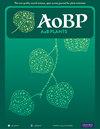从植物标本馆标本中提取长DNA
IF 2.6
3区 生物学
Q2 ECOLOGY
引用次数: 0
摘要
摘要利用短读平台对植物标本DNA进行高通量测序,有助于探索许多生物学问题。在这里,我们首次研究了利用植物标本馆标本作为长读DNA测序技术资源的潜力。我们利用12个植物标本中48个低拷贝核位点的目标捕获作为SMRT PacBio Sequel长读测序的基础。这些样本是在1932年至2019年间收集的。一个简单的大小选择协议使检索两个长DNA片段(>1kb),其中9个有较长的目标读取。有限的样本量无法统计评估标本年龄对DNA片段化的影响,但我们的结果证实,较年轻的样本,即在1990年之后收集的样本,碎片化程度较低,测序成功率高于在此日期之前收集的样本。1990年至2019年收集的样本产生167至3403个目标读数。1 kb。它们可以恢复34到48个基因座(即,所有的基因座都恢复了)。1990年以前采集的标本中有3个样本没有产生目标读数。1 kb。在此日期之前收集的其他四个样本产生了多达144个reads,并恢复了多达25个位点。年轻的植物标本似乎很有希望进行长时间的测序。然而,较早的计划在一定程度上失败了。进一步的探索是必要的,以统计测试和了解旧材料在寻求长阅读方面的潜力。我们将鼓励大大扩大采样规模和比较不同的分类群体。本文章由计算机程序翻译,如有差异,请以英文原文为准。
Retrieval of long DNA reads from herbarium specimens
Abstract High-throughput sequencing of herbarium specimens’ DNA with short-read platforms have helped explore many biological questions. Here, for the first time, we investigate the potential of using herbarium specimens as a resource for long read DNA sequencing technologies. We use target capture of 48 low copy nuclear loci in twelve herbarium specimens of Silene as a basis for long read sequencing using SMRT PacBio Sequel. The samples were collected between 1932 and 2019. A simple size selection protocol enabled retrieval of both long DNA fragments (> 1kb) and long on-target reads for nine of them. The limited sampling size does not enable statistical evaluation of the influence of specimen age to the DNA fragmentation, but our results confirm that younger samples, i.e. collected after 1990, are less fragmented and have better sequencing success than specimens collected before this date. Specimens collected between 1990 and 2019 yield between 167 and 3403 on-target reads > 1kb. They enabled recovering between 34 loci and 48 (i.e., all loci recovered). Three samples from specimens collected before 1990 did not yield on-target reads > 1 kb. The four other samples collected before this date yielded up to 144 reads, and recovered up to 25 loci. Young herbarium specimens seem promising for long read sequencing. However, older ones have partly failed. Further exploration would be necessary to statistically test and understand the potential of older material in the quest for long reads. We would encourage greatly expanding the sampling size and comparing different taxonomic groups.
求助全文
通过发布文献求助,成功后即可免费获取论文全文。
去求助
来源期刊

AoB Plants
PLANT SCIENCES-
CiteScore
4.80
自引率
0.00%
发文量
54
审稿时长
20 weeks
期刊介绍:
AoB PLANTS is an open-access, online journal that has been publishing peer-reviewed articles since 2010, with an emphasis on all aspects of environmental and evolutionary plant biology. Published by Oxford University Press, this journal is dedicated to rapid publication of research articles, reviews, commentaries and short communications. The taxonomic scope of the journal spans the full gamut of vascular and non-vascular plants, as well as other taxa that impact these organisms. AoB PLANTS provides a fast-track pathway for publishing high-quality research in an open-access environment, where papers are available online to anyone, anywhere free of charge.
 求助内容:
求助内容: 应助结果提醒方式:
应助结果提醒方式:


